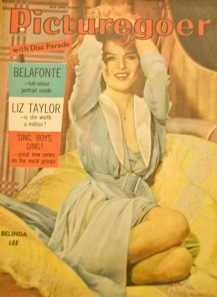My team, Emily, Isabel, Sophie, and Guilia are discussing the history and background to the themes and pieces we included in our collection in their accompanying blog post. In this post I will go on to describe the process of putting the display together and then I will concentrate on Belinda Lee, the British actress who was captivated by Italy in the 1950s.
We began by pouring over the material that Phil had selected from the BDC, reading and comparing images to work with. Then we moved on to searching the archive ourselves, taking boxes from shelves and opening up filing cabinets to find items like the Studio Beauty Contest Exhibitors Guide entitled “The Search for Beauty” (EXEBD 77034) which, although dating from the USA in the 1920s, became the inspiration for our title for the display, because it is so resonant of the role of women in Italian Cinema of the 1950s.
Inevitably there were too many beautiful pieces that we wanted to fit into our small space. Of the many things we left out of the final display, I found one set of photographs of Sophia Loren particularly interesting. The images showed her with some US soldiers in Italy before going over to Hollywood. She was playing snooker and picking up their accent, showing Loren in the transition from Italy to Hollywood. Another image I wanted to include, which was unfortunately too large to fit into our cabinet, was an image of Anita Ekberg “as a huge symbol of eroticism, dwarfing the models specially built to reproduce the monumental architecture commissioned and erected by fascists in Rome for the… universal exhibition that never took place.” This image and this quote came from a book in translation by the Italian director Fellini on Cinecittà film studios.
To help us narrow down our selection we decided upon a few key themes for our display to showcase the most beautiful and significant images. We wanted to explore how the private lives of these actresses were presented in the public eye, moving on through this to stress the serious and often powerful female characters that were a part of the Italian film industry at the time. Finally, to me, the glamourous “maggiorata” “Italian movie goddess” image had to be central to the display. It defines the sensual Italian glamour associated with Italian women on screen in the 1950-60s.The companion piece to this post written by my team of Italian film students explores these categories in much more detail.
We decided to include Belinda Lee in our display as she was an outsider seduced by the Italian film industry, highlighting the allure of its uncensored passion. The British Rank Organisation starlet from Budleigh Salterton, only 15 miles south of Exeter, left behind the wholesome roles offered at home for more sensual parts in Italian films. In England, Belinda Lee had never really been allowed to break from the on-screen image of a privileged but naive young woman. When she moved to Italy her scandalous private life seemed to match the scandalous roles she played. Not only was she seduced by the sexual liberation she was given on screen but she began an affair with an Italian aristocrat, Prince Filippo Orsini. They entered into a suicide pact, which they did not go through with, but which made Belinda Lee into a European celebrity. In 1958 she was dropped by Rank Organisation but the scandal worked to her advantage. She was offered many more risqué roles, showing how her private life was being used to define her on-screen persona.
The fact that Belinda Lee had lost fame in Britain by the time of her death in 1961 shows the divide between British and continental film at the time. In the issue of Picturegoer from 5 December 1959 we included in our display there is a section ‘On the Covergirl’ which discusses Belinda Lee:
“Our cover picture reminds you of the beauty that is Belinda…of the beauty that we are not likely to see on British screens for a long time to come. For what a transformation in the curvy, blonde Belinda Lee who was, at one time, one of our top glamour girls! Quitting this country, the RankOrganisation and cameraman-husband Cornel Lucas for the delights of Rome, Miss Lee is now an Italian-accented beauty living quietly on the Continent.”
So Belinda Lee was the British starlet who became mesmerised by Italian cinema and in this way I felt like I could relate to her. Surrounded by my Italian film students I felt like I was undertaking a much more sedate and curatorial version of Belinda Lee’s adventure into the new and exciting world of Italian film.
You can look at images from the exhibition at our Facebook album “The Search for Beauty: Italian Women on Screen” on The Bill Douglas Centre’s facebook page.







